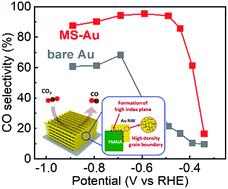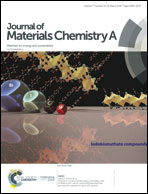Versatile, transferrable 3-dimensionally nanofabricated Au catalysts with high-index crystal planes for highly efficient and robust electrochemical CO2 reduction†
Abstract
Considerable interest has been shown in the electrochemical CO2 reduction reaction (CO2RR) for transforming CO2 into other value-added carbonaceous products such as CO. In this work, we prepared multi-stacked Au (MS-Au) nanowire arrays with tailored active reaction sites and controlled 3-dimensional structures by oblique angle deposition and a sequential solvent-assisted nanotransfer printing (S-nTP) method for highly selective and efficient electrochemical CO2RR. Our MS-Au nanowires exhibit high CO2RR activity in a wide range of overpotentials due to the electrochemically active high index grain faces and high grain boundary density and by controlling local reaction environments. With our 10 layers of MS-Au nanowires, we achieve ∼13 times higher CO2RR geometric current density (jCO) at low overpotential (−0.39 V) compared to the pristine Au thin-film electrode. Finally, the S-nTP method allows versatile transferability of MS-Au nanowires onto a gas diffusion electrode in a flow reactor to maximize CO evolution with an exceptional mass activity of ∼172.66 A g−1 at an overpotential of only 80 mV.



 Please wait while we load your content...
Please wait while we load your content...